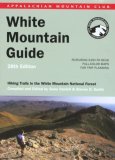 |
| ...More Topics... |
 Books Books |
 Bulletin Board Bulletin Board |
 Clubs & Huts Clubs & Huts- AMC Huts |
 Feedback Feedback |
 4,000 footers 4,000 footers |
 Hiking Glossary Hiking Glossary |
 Mail List Mail List |
 Privacy Policy Privacy Policy |
 Store Store |
 Weather Weather |
| Search |
|
|









[an error occurred while processing this directive]


|
Quick Facts
(And Overall Rating) |
Only seven years without incident, I'll have to get back to you . . . |
| Size (capacity) |
2880-3880 or 3330-4330 cu. in. - in
3 (Depends on frame size) |
| Weight | 5 lbs. 4 oz. |
| Frame Style | External |
| Key Features |
|
The Camp Trails McKinley was the first real pack I ever purchased. After almost no research whatsoever, I descended on the Kittery Trading Post and sought the knowledge of the nearest camping associate. After and hour of discussion and pack fitting, the McKinley was my choice.
Let me start out by saying that I did try on a series of internal frame packs. Although Internals were the "in" thing that all the fashionable hikers were wearing, I chose an external frame pack for all the right reasons -
- It's cooler (I'm a very hot hiker)
- I'm not doing any bushwhacking to speak of
- It isn't built like a giant garbage bag with a metal rod inserted for support (no external pockets on most internals)
- It's sturdier
- You can turn an external frame pack into a gurney with McGuyver, some twine, and a stick of bubble gum
As you can tell, I don't buy packs based on the "in" thing to do. When pack shopping, I determined that I would be doing very few of the things that make an internal frame useful (winter hiking, bushwhacking, ice climbing, etc.), but I still wanted a perfect fit, and adjustments for when I needed them. The McKinley fit the bill and even offered a few extras.
For comfort, the McKinley has a thickly padded hip belt, shaped and contoured to fit. Multiple "micro" adjustments allow you fit the belt to your favorite position with little effort. Shoulder straps are also well padded, although somewhat thin, and have three width and five height adjustments. Lash points for sunglasses, GPS sleeves, and Rambo knives are also featured on the shoulder straps.
At 3330-4330 cu. In., the McKinley is big enough for extended trips without suffering from extra weight (the large version weighs 5 lb). Five external pockets all you to stow your gear in logical places for easy access, eliminating the need to drop your pack and search every time you want an energy bar. Although the version of the McKinley that I have does not have it, the addition of an angled, insulated water bottle pocket makes breaks a little less involved. A bonus map pocket is also places just behind the head for easy access.
The main compartment of the McKinley is large and deep, and features a spindrift collar for overstuffing. A lower sleeping bag compartment is large enough to hold a stuffed 0º bag, although I use it more for food or clothing. Both compartments can be cinched closed with a strong nylon cord with spring locks. One added feature that I like is the large flap that covers the top of the pack. This can be used in a number of ways to make your life easier, as it can conform to a pair of snowshoes as easily your sleeping pad, and it is also cinched down using J-hooks down the front of the pack.
The devil's advocate side of me requires that I divulge the few things that I feel could be improved as well. First, the support rods that create stiffness in the top compartment are rather flimsy: they bend easily and cause the top compartment to contort. Second, a pin at the bottom of the frame has pushed through to the hip belt, creating a gnawed-out spot that looks like a mouse thought that nylon was tasty. This was caused by a weak cotter pin that stretched, which I didn't notice.
Camp Trails' Lip Service:
You can't beat the great capacity and features of the McKinley. A top loading main compartment and bottom panel opening give you easy access and organization. While five pockets allow more room for storage. The tunnel side pocket lets you store long gear like tent poles. An insulated water bottle pocket provides quick access to your water.
My Lip Service:
A solid performer, you can't really go wrong with the McKinley. It has all of the amenities that you expect from a piece of gear and costs about half of what a comparable internal frame pack costs. Pockets and compartments are spacious and useful, and the extras make life a whole lot easier.
UPDATE: The Camp Trails brand is now focused exclusively on tents, and you will not find any information about this pack on their web site, which is dumb if you ask me.
Chris Oberg & Robert Havasy
Hike-NH.com




